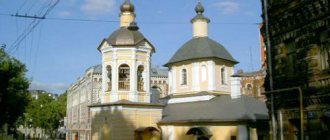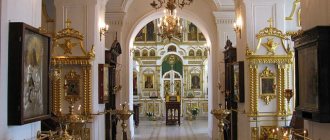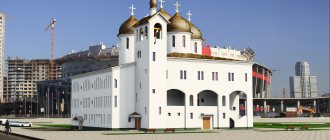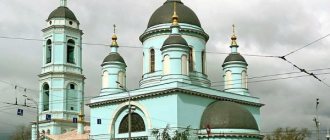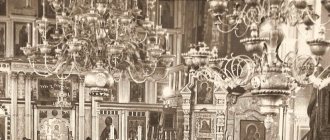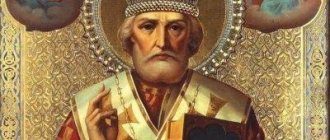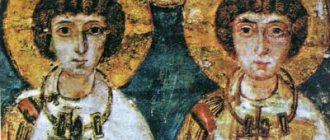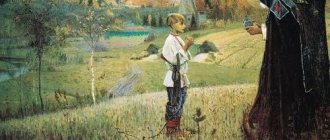| Moscow Church of St. Sergius of Radonezh, in Rogozhskaya Sloboda. Northern façade. June 25, 2010. Photo by Alexander Chebotar. |
Moscow Church in the name of Sergius of Radonezh (the Life-Giving Trinity) in Rogozhskaya Sloboda
(Pokrovsky Deanery of the Moscow Diocese)
- Thrones: Life-Giving Trinity (main), chapels: St. Sergius of Radonezh and St. Nicholas the Wonderworker.
- Address: Russia, Moscow, st. Nikoloyamskaya, 57-59
- Tel.: 8(495)-912-14-90
- Official site:
- On the map: Yandex.Map, Google map
The first mention of a wooden church in the Rogozhskaya Yamskaya Sloboda dates back to 1625.
In the lists of 1722 and 1727, the church is already listed as a stone church; the tented bell tower of this building was preserved until 1864. The one-sided refectory was dismantled in 1796 and instead, by 1800, a new one was built with two altars: St. Sergius and St. Nicholas.
The current main church was built in 1818. There was a fire in 1837, and renovation in 1838. In 1864, the construction of a new high bell tower followed.
In 1812, during the invasion of the French, the church was looted, then the temple burned down in a fire, but the utensils, buried in the ground, were saved. Located next to the Old Believer area, the temple had a unique collection of ancient icon painting. In 1876, the walls were painted by A. S. Rogozhkin.
| Moscow. Church of St. Sergius the Wonderworker in Rogozhskaya. 1882 Naydenov N. A. Moscow. Cathedrals, monasteries and churches. Part IV: The area behind Zemlyanoy Gorod. M., 1883, N 59 |
On November 2, 1899, the auditorium was consecrated for interviews with Old Believers, spiritual concerts and religious and moral readings.
In 1916-1918, Hieromartyr Joseph Schensnovich (+ 1937) served as a psalmist in the church.
Since the 1920s, the martyr John Malyshev (+ 1940) was a parishioner of the temple; in December 1937 he became a member of the church twenty.
In the fall of 1937, the rector of the temple, holy martyr Peter Nikotin, and the singer, martyr Nikolai Kuzmin (+ 1937) were arrested.
In 1938 the temple was closed. All the ancient icons of the temple disappeared irretrievably (including the Jerusalem Icon of the Mother of God). For a long time the temple stood with tattered domes and knocked down crosses. At the end of the 1950s, the remnants of the old coatings were removed and painted iron was installed instead. The building was used for workshops and storage.
| Church of St. Sergius of Radonezh, in Rogozhskaya Sloboda. View from the east. November 1972. Photo by Alexander Chebotar |
Until 1984, the church remained without a cross.
Inside, in 1984, the main room housed the sculpture workshop of the Art Foundation. Restoration of the temple was not planned, although it was in poor condition. In 1985, the temple was transferred as a branch to the Central State Museum of Ancient Russian Culture and Art named after Andrei Rublev. By 1990, restoration was carried out.
On August 31, 1990, the temple was returned to believers.
On December 4, 1991, Bishop Sergius (Fomin) of Solnechnogorsk performed the minor consecration of the main altar.
There is a Sunday school. Discussions are held for children and adults.
Palekh church painting
The three-tier bell tower was built later, in 1864. In 1876, the temple was painted by the famous Moscow icon painter Andrei Semenovich Rogozhkin, as they said then, in the “ancient patristic Orthodox style.” Now art historians define this style as Palekh. Since Old Believers lived in Rogozhskaya Sloboda, they tried to attract them to Orthodoxy. They bought icons of ancient writing for the temple; if they bought new ones, they were stylized to resemble the 15th-16th centuries. They said that the temple on Rogozhskaya Sloboda could compare even with the Kremlin shrines in its collection of wonderful ancient icons. In November 1899, a special place was consecrated in the Sergius Church for conversations with Old Believers, for religious readings and spiritual concerts. Special notes were made for the wonderful choir of the blind, which was considered one of the best in Moscow.
Activities of the parish
Over the decades after the opening of the temple, a community was formed here, which developed active efforts to catechesis the local population and attract people to the current tasks facing the community of the St. Sergius Church.
- There is a Sunday school for both children and adults.
- A pilgrim group has been organized that travels to all the holy places of Russia.
- There is a volunteer team that is engaged in social activities.
All this suggests that the community is developing quite active activities in the territory under its jurisdiction.
Atheistic bacchanalia
The revolution and the rampant militant atheism erased all the centuries-old efforts to improve the temple. In 1937, after the arrest of the rector and active parishioners, newly-minted atheists chopped down ancient icons with axes. Books and church decorations were burned at the stake. The destroyers of temples did not hesitate to burn priceless notes for the blind. What was created and acquired with love and patience over centuries died in a few hours in an atheistic bacchanalia. Only a few ancient icons were saved. One of them is the miraculous icon of the Mother of God “Quench My Sorrows,” which was transferred to the Church of St. Nicholas in Kuznetsy, which is still there today.
Shrines
Among the shrines of the Church of St. Sergius of Radonezh in Krapivniki there is an extremely rare relic, which by some miracle was preserved only in this abode of the Most High God. This is the Kiy cross, made in 1656 by order of Patriarch Nikon, in the cross itself are placed:
- hundreds of particles of saints of the Orthodox Church;
- dozens of stone particles associated with various sites in Palestine and sacred sites mentioned in the Bible
Kiysky cross - a collection of particles of shrines of the Holy Land and relics
The cross itself is decorated with small crosses with particles of relics of unknown saints. These small crosses were made on Mount Athos.
Interesting! The history of the cross itself is connected with the name of Patriarch Nikon, from the moment when, out of pride, he fled from his mentor and almost died in the abyss, but his boat washed up on the island. Nikon erected a cross, which was named Kiysky after the name of the island.
Another shrine is an 18th-century copy of the Feodorovskaya Icon of the Mother of God. The original from this shrine is the only relic of the Soviet era that was not kept in museums.
Also in the temple there is an icon of St. Sergius of Radonezh, dating back to the second half of the 17th century, it contains a particle of the relics of the saint. All these shrines are now a rarity for parish churches. Most of the Orthodox relics were lost.
Soviet past
Since the late fifties of the twentieth century, the Church of St. Sergius of Radonezh in Rogozhskaya Sloboda was used for workshops and warehouses. At the end of the 70s, welding sparks were already flying in the central aisle; workers, swearing and smoking cigarettes, were welding parts of the monument to Gagarin, which now stands on Leninsky Prospekt in Moscow. Showers were also installed here, where people washed after work. Then no one knew or thought that all this was happening literally on the graves and bones of executed people. The terrible truth about what was happening in the house of God before the fifties was learned only when the Church of St. Sergius of Radonezh in Rogozhskaya Sloboda was handed over to believers, and only then did serious restoration begin.
History[edit]
The Church of St. Sergius of Radonezh the Wonderworker, “what is in Starye Storozhi”, “what is in Starye Serebryaniki”, “on Petrovka”, “in Krapivniki”, “on Truba” has been known from documents since 1591. It is located opposite the south-eastern wall of the Vysoko-Petrovsky Monastery, founded by Metropolitan Peter in the 14th century and which owes its prosperity to the patronage of Peter I and the Naryshkins.
The exact time of construction of the Sergius Church is not known; the description of the 19th century presumably indicates 1591. So far, the only documentary evidence of this date is the so-called “Petrov’s drawing” (1597), in which you can see a small one-domed temple on the descent from the Vysoko-Petrovsky Monastery to Neglinnaya. The name of the area “Old Serebryaniki” indicates that the yards of silversmiths - artisans who worked at the Mint - were located here.
The definition “on Petrovka near Truba” indicates the location of the temple in the alley between Petrovka and Trubnaya Square. And opinions vary about the origin of the name “in Krapivniki” (or “in Krapivki”). Most often they say that the local area was abundant in nettles. There are other versions: “Another lane in these places is Krapivensky. Its name is associated with thickets of nettles, which supposedly grew especially lushly here. However, in Moscow, alleys were usually named after the last name of the most prominent homeowner who lived in it. A document of 1752 mentions a certain collegiate assessor Alexey Krapivin, who lived here - perhaps the name of the lane came from his last name" (S.K. Romanyuk. From the history of Moscow lanes (1988)).
It is difficult to say whether in the 17th century the backyards of the Vysoko-Petrovsky Monastery were so remote and thicket as to give the name to the lane. According to Sigismund's plan for Moscow in 1610, the entire space between Petrovka Street and the Neglinnaya River was built up with wooden houses. However, on Gorikhvostov’s plan of 1767, separate courtyards are scattered east of Petrovka, there are no city blocks; along the low-lying bank of Neglinnaya, a floodplain meadow or wasteland is shown in dark tone, possibly resulting from fires in the first half of the 18th century. In the Census Books of 1738–1742, the area behind the courtyards of the parishioners of the Church of St. Sergius the Wonderworker towards Neglinnaya is listed as “voiceless.”
The Church of St. Sergius was first mentioned in documents in 1625. The church is called wooden, and it is written that “priest Ivan paid a tribute of 18 altyn 2.” The same entry is repeated in 1628.
In 1631–1632, there were 40 households in the church parish, the priest was Kuzma Ignatiev. Over the next 6 years, the parish increased by 14 households, and in the Census Book of 1638, “Sergius the Wonderworker of the Old Silvers” already recorded 54 households - including the courtyard of priest Agathonik, the households of the steward Semyon Yakovlev, son of Velyaminov, Prince Theodore, prince Vasilyev, son of Dolgorukov, prince Vasily Prince Grigoriev's son Kozlovsky, his son the steward Prince Alexy, Mikita Prince Levontev the son of Shakhovsky, the steward Mikifor Ivanov the son of Pleshcheev, the solicitor Prince Yury Prince Mikhailov the son of Ukhtomsky and others.
We can roughly imagine what the church looked like in the first half of the 17th century from Merian's plan dating back to 1638. It depicts a tented wooden church.
In 1639, a census of Moscow churches was carried out, but the Church of Sergius in Starye Serebryaniki was missed, as reported in the Building Book of 1657.
In 1677, the church burned down, and therefore the church authorities issued a decree: “It was ordered to take half of this money from this church for the fire destruction.” Most likely, the construction of the stone temple began next year. In the Scribe Book of 1680, it is already shown as “the church of St. Sergius the Wonderworker, which is near the Trumpet, made of stone.” On Gotofred's plan (1695), the St. Sergius Church appears as a modest quadrangle with a mosquito roof and one onion-shaped dome.
Apparently there was a bell tower next to the church. Where exactly it was located and what forms it had is unknown. But until the end of the 19th century, the inset bell of 1689 was preserved in the Sergius Church, which “was applied from a small alms for their many sins by the steward Prince Mikhail and Prince Ivan Yuryevich Ukhtomsky in the church of the Venerable Father Sergius the Wonderworker, which is between Petrovka near the Neglinnaya River, near the Truba, in Starye Serebryaniki, to commemorate their deceased relatives.” The bell weighed 73 pounds (approximately 1,200 kg).
About twenty years passed, and a chapel with a refectory dedicated to John the Baptist was added to the southern wall of the temple. This reconstruction is not reflected in the documents, however, it is known that on March 21, 1702, “an antimension was issued to the Church of St. Sergius the Wonderworker, which is in the White City near the Pipe, in Starye Serebryaniki. Deacon Stefan Alekseev took it.” Antimensions were issued to newly consecrated thrones. Therefore, we can confidently assume that not long before that, the construction of the Predtechensky chapel was completed.
It is also known from the Census Books of 1702 that priest Alexei Ivanov served in the church, and there were 47 households in the parish.
During the French invasion in 1812, the church was plundered and, apparently, suffered greatly, since it does not appear on the lists of survivors in the Tver part. By decree of the Holy Synod of April 9, 1813, it was assigned as a parish-free church to the Church of Gregory the Theologian, near Dmitrovka. The utensils and property of the St. Sergius Church were described, some were taken to the Church of St. Gregory, and the icon of St. Sergius was transferred to the church in the village of Borodino in 1816.
After the abolition of the Sergius parish, the houses of the clergy were dismantled, and in 1828, in view of the requirement of the civil authorities that all houses in the White City be made of stone, the headman and parishioners of the Church of Gregory turned to Metropolitan Philaret (Drozdov) of Moscow with a request for permission to dismantle the dilapidated Sergius Church, and the material will be used to build houses for the clergy.
The Metropolitan did not approve of this initiative, wishing to preserve the holy temple intact. In 1847, he himself examined the Church of St. Sergius and, finding it “solid, well-finished,” proposed it for the construction of the Antioch metochion, but the Metropolitan of Iliopol preferred the Ascension-Ipatiev Church in Kitai-Gorod.
In 1848, representatives of the Athos Panteleimon Monastery petitioned for the transfer of the St. Sergius Church for the establishment of a metochion, but the clergy and parishioners of the St. Gregory the Theological Church did not agree to cede the assigned temple to the Athonites “out of reverence for the saint of God, St. Sergius.” Metropolitan Philaret was also against the establishment of an Athos metochion in Moscow. “It’s another thing to go to Athos for silence,” the Bishop wrote to the chief secretary of the Holy Synod, A. N. Muravyov, “and another, after leaving for Athos, with the name of the Athonite silencer, to go live in the Moscow rumor, in the courtyard.”
In 1870, the parishioners and clergy of the St. Gregory Church again refused to hand over the Sergius Church, now for the establishment of the Serbian metochion, pointing out that this is the only parish church in Moscow, where the main altar is dedicated to St. Sergius of Radonezh.
In 1875, “the church was restored by the parishioners with gilding of all three of its iconostases. Divine services were held there on all major holidays.” In the same year, an unpleasant incident happened: thieves visited the temple.
By the beginning of the 1880s, there were no ascribed churches left in Moscow. In 1883, the St. Sergius Church also ceased to be ascribed: by decree of Alexander III of November 15, 1883, it was transferred to the Patriarchate of Constantinople for the establishment of a metochion. The church was accepted by Archimandrite Seraphim (Skoruli) according to the inventory.
At that time it contained two Gospels, a paten and a silver gilded chalice with the inscription that it was built in the Church of Sergius in 1775. The sacristy was empty, but the iconostases were intact.
In the 1920s of the 20th century, the St. Sergius Church, as an ancient monument, was registered with the Museum Department of the People's Commissariat for Education. Being a metochion of the Patriarchate of Constantinople, the temple remained active for quite a long time. In the 1920s–1930s, its rector was Archimandrite Vasily (Dimopulo). The colorful image of Archimandrite Vasily was preserved in the memoirs of the artist and Church historian M.E. Gubonin. There is also an article dedicated to him by priest Alexander Mazyrin, an employee of the department of general and Russian church history and canon law of PSTGU, “The last representative of the Patriarch of Constantinople in Moscow, Archimandrite Vasily (Dimopulo) and his church-political activities” (2013).
In 1922, valuables were confiscated from the Church of St. Sergius, and the confiscation was accompanied by riots. A mention of them is contained in Information Report No. 92 of the Moscow Provincial Department of the GPU “On the political state of Moscow and the province for April 25, 1922”: “Today a crowd of boys gathered at the Church of Sergius (Trubnaya Square) who threw at the members of the commission (meaning the commission on the seizure of church valuables. - Ed.) stones. Appropriate measures were taken and the crowd was dispersed by a detachment of cavalry.”
In 1925, the housing association that united the houses surrounding the church built a wood shed between the street fence of the site and the wall of the church, which the Museum Department objected to, since the shed threatened the fire safety of the temple.
After the closure, the upper tier of the bell tower was destroyed, new windows were broken into the walls, and a door was opened in the central apse. The temple building housed workshop No. 2 of the First Moscow Skate Factory, which produced skates and ski bindings.
In 1984, art critic N.V. Galaktionova prepared a project for the restoration of the Sergius Church.
In 1991, the Church of St. Sergius was reopened as the Patriarchal Metochion. On August 30, 1991, His Holiness Patriarch Alexy II consecrated the central altar of St. Sergius with the rite of minor consecration. The first rector of the Sergius Church after its return to the Church was Archpriest John Ekonomitsev (later Archimandrite), and the clergy included Archpriest Gleb Kaleda, Priest John Vavilov, and Priest John Sviridov. After the Church of St. Sergius of Radonezh in the Vysoko-Petrovsky Monastery was handed over to the believers in 1993, the clergy moved there, and Priest John Vavilov remained in the Sergius Church in Krapivniki, becoming its rector.
On January 15, 1998, the dean of the Sretensky deanery, Archpriest Oleg Klemyshev, consecrated, with the blessing of His Holiness Patriarch Alexy II, the former St. Nicholas chapel in the name of St. Seraphim of Sarov.
The Church of St. Sergius entered the new millennium with a recreated bell tower. The decision to restore it was made at the beginning of 2000. I. V. Konovalov, senior bell ringer of the Moscow Kremlin and the Cathedral of Christ the Savior, chairman of the Society of Church Bell Ringers, worked on the resumption of ringing. The project was carried out using stereophotogrammetry using a photograph from Naydenov’s album. The method made it possible to restore the dimensions and shape of the bell tower with an accuracy of several centimeters. The entire selection of bells has also been recreated - from one hundred poods to eight kilograms: 100, 50, 25, 15, 8, 4, 2, 1 and 0.5 poods. Upon completion of the work on December 15, 2001, a cross with four banners was installed on the bell tower.
The first ringing of the stopudovo bell took place at the all-night vigil on Epiphany in 2002. Bells weighing 50 and 25 pounds were made and delivered to the temple in the spring of 2002. On April 5, 2002, the consecration of the bells in the bell tower took place. The first ringing of all the bells sounded on Annunciation 2002.
In 2010, Archpriest Alexander Abramov was appointed rector of the temple. In the same year, a small consecration of the chapel of All Saints, who shone in the Russian land, took place. Scientific restoration of the appearance of the temple and its shrines has begun (and continues). In 2013, the Serafimovsky chapel received new decoration: the painting of the altar part was done by Irina Zaron, the altar barrier was done by Sergei Antonov. In 2014, work was completed on rehanging the bells and gilding the heads of the bell tower and the temple.
Terrible finds
The restorers of the temple went down to the basements, and what they saw there shocked them to the core. Bones were stacked in stacks, lightly sprinkled with sand, and there were bullet holes in the skulls. After a request to the relevant competent authorities, it was possible to establish that the temple of St. Sergius of Radonezh in Rogozhskaya Sloboda, for whose sake State Councilor G.P. Smolyansky once spent his entire fortune so that his descendants would have spiritual joy and consolation, was turned into a testing ground for carrying out sentences. The bones of the sufferers were buried according to Christian custom. A cross was placed over the mass grave, on which it was written: “They were tortured in order to receive the Resurrection.” Requiem services are regularly held over the grave.
Pilgrim[edit]
Schedule of services:
On Saturday - Divine Liturgy at 8.00. On Sundays, as well as on the days of the twelve and great holidays - Divine Liturgy at 9.30, on the eve of the All-Night Vigil at 17.00.
On Friday at 17.00 there is an akathist at the Miraculous Kiysk Cross (except for the days of Great Lent and All-Night Vigils of holidays). Passions and all services to the Cross are performed at the Miraculous Kiysk Cross.
On days of especially revered saints and icons of the Mother of God - Matins and Divine Liturgy at 8.00.
Schedule of services for the month
The last abbot
In the Cathedral of Russian New Martyrs and Confessors, the last rector of the church before its closure, Archpriest Peter Nikotin, is also commemorated. Among the accusations brought against Father Peter were complaints from one citizen who was denied communion on the grounds that she did not know who Christ was, but knew perfectly well who Lenin was. A paid informant left for history the words of the Hieromartyr Peter: “Without Christ, man cannot live; where there is no Christ, there is swearing, fights, quarrels. There is no more shame or honor there." The same informant accused Father Peter of preaching the church as the only place for the salvation of the human soul. Father Peter was shot along with his parishioners at the Butovo training ground and buried in an unknown common grave. The temple has his icon, as well as his image painted in the central chapel.
Revival of the shrine
December 4, 1991 became a real holiday for all Russian Orthodoxy. Bishop of Solnechnogorsk Sergius Fomin conducted a minor consecration of the temple. From that time on, the revival of the shrine began. After several years of hard work, the chapels of St. Sergius of Radonezh and St. Nicholas the Wonderworker were completely restored. Ancient painting once again shines with bright colors. However, there is still a long way to go until all the work is completed. Very often there is not enough money for everything, so restoration work has to be frozen. Based on old photographs, the restoration of the main iconostasis is underway. Miraculously, the holy icon of Seraphim of Swarovsk, which was painted on the wall of the temple, was almost completely preserved. Many fragments of the painting have to be reconstructed.
About the temple
More than 160 thousand people live in the Golyanovo district of Moscow. Until recently, in our area, essentially only one temple was open to believers. Then it was decided to allocate a plot of land on Krasnoyarskaya Street, opposite house 11, to the Orthodox Church for the construction of a new church.
The first plans were to build a temple on this site in honor of the holy martyr Hermogenes, Patriarch of Moscow. However, subsequently another site was allocated for the construction of this temple, and on Krasnoyarskaya Street it was decided to build a temple in honor of St. Sergius of Radonezh. And this is not without reason: in 2014, Russia celebrated the 700th anniversary of the birth of the great saint.
A young priest, Priest Peter Ivanov, was appointed rector and responsible for the construction of the new church. It fell to his lot to lead the prayers and labors aimed at the construction of a new temple of God. The community got a difficult site for construction: on one side, the site is “propped up” by a stream that overflowed parallel to the Moscow Ring Road, and on the other, by a massive garage cooperative. Currently, only a small area is available to us for free activity: 9x14 meters. If we compare it with the size of the entire territory of the future temple as a whole - which is 0.51 hectares - it turns out that this is quite a bit. In such a situation, “extra” meters of free land would not hurt us, but if we can “ask a stream to move,” then this will not work with a garage cooperative. The last thing we would like is for people to be offended, upset or embittered as a result of the construction of the temple. For this reason, we have decided to use the land that God has given us now. Let us pray that over time the Lord will arrange and resolve this difficult situation in the best possible way.
At first, on this free “patch” there was a prayer house - a small building made of boards and covered with a simple gable roof. Here, for several months, the community gathered on Sundays to pray for ourselves, for the future temple, for our living and deceased relatives and friends. The number of parishioners grew. It became clear that we needed a small and inexpensive temple.
Thanks to the prayers, labors and donations of our parishioners, it took a little more than a year for a temporary church to be erected on a vacant lot with God’s help in the name of St. Sergius of Radonezh. On December 4, 2014, on the feast of the Entry of the Most Holy Theotokos into the temple, Bishop Panteleimon of Orekhovo-Zuevsky performed the rite of consecration of our temple. Now we all have the opportunity to regularly attend services, receive communion, receive unction, get married, baptize children and see off our loved ones on their last journey. This year we collectively celebrated Great Lent within the walls of our church and celebrated the Holy Resurrection of Christ. It is joyful to see that on the days of great church holidays our church is always full. And there are more and more parishioners at regular Sunday services. Now is a difficult, but very fertile and very interesting time for all of us. We pray and work, we want to do everything so that a bright and spacious temple appears in this place.
Construction of a temporary temple begins
Temporary Temple
Consecration of the throne 12/04/2014
Currently, a project has been drawn up for the construction of a large stone temple, accommodating approx. 500 people. An important part of the project is also the parish educational center, an analogue of modern cultural palaces.
The rector of the temple, Priest Peter Ivanov
Father Peter was born on May 4, 1986 in Moscow in the family of a military man and a housewife. The father of Priest Peter Vladimir Alekseevich subsequently became the headman of the Church of the Ascension of the Lord on Bolshaya Nikitskaya Street. In the same church, Father Peter was an altar server from 6 to 23 years old. At the moment, the father of Priest Peter is the headman of our church.
Father Peter graduated from the Traditional Gymnasium in Moscow (now the Orthodox St. Peter's School) and in 2003 entered the PSTGU (Orthodox St. Tikhon's Humanitarian University) at the Faculty of Theology. Father Peter holds a bachelor's and master's degree in theology, and from 2009 to 2011, Father Peter also studied in graduate school.
November 18, 2009, the day of remembrance of St. Tikhon in the Donskoy Monastery, at the relics of the saint, Bishop Alexander Dmitrovsky ordained Father Peter to the rank of deacon. And on July 7, 2013, Bishop Ignatius Dmitrovsky ordained Father Peter as a priest in the Church of John the Baptist on Presnya.
From 2013 to the present, Father Peter is responsible for youth work, secretary and member of the council of the Eastern Vicariate of Moscow. From 2009 to 2021 he taught dogmatic theology at PSTGU.
Father Peter is married and has five children.
You can contact Father Peter at: +7(926)264-76-88
Name day: July 12, in honor of St. ap. Petra
______________________________________________________________________________
Priest Vadim Pismenny
Father Vadim was born on September 18, 1962 in the city of Dzerzhinsky, Lyubertsy district, Moscow region, into a family of engineers.
In the 1980s, Father Vadim graduated from the Moscow Medical Dental Institute, and from 1994 to 1997. studied and received his education at the Greek Orthodox Theological Academy of the Holy and Life-Giving Cross of the Lord in the city of Brookline, Massachusetts in the USA.
On December 6, 1998, Father Vadim was ordained a deacon, and on January 30, 1999, he was ordained a priest.
Father Vadim was rector of the Holy Spiritual Church in Bridgeport, Connecticut, USA from 1999 to 2010, and was also rector from 2010 to 2011. in the church of St. John of Shanghai and the Wonderworker of San Francisco in the city of Framingham, Massachusetts in the USA. In 2011-2013, Father Vadim served as a cleric at the New Root Monastery in Mahopac, New York, USA. From 2013 to May 2021, Father Vadim served as a cleric at the Church of the Resurrection of Christ at the Semenovskoye cemetery in Moscow.
From 1987 to 1990 Father Vadim worked as an ambulance doctor in the city of Ivanteevka, Pushkin district, Moscow region. Also in the 1990s, Father Vadim worked as a consultant on psychological and psychotherapeutic assistance, and also worked as a psychotherapist at a youth medical center.
Father Vadim is married and has an adult son.
Name day: April 22, in honor of the Great Martyr. Vadim.
______________________________________________________________________________
Priest Boris Veklenko
Father Boris was born on March 8, 1973 in Moscow. His father is a professor, Doctor of Physical and Mathematical Sciences, Master of Sports in Sambo, currently working at the Research Institute of the Russian Academy of Sciences. Father Boris’s mother is a Doctor of Technical Sciences, master of sports in skiing, professor at the Moscow Energy Institute.
From 1990 to 1999 father Boris studied at the Moscow Energy Institute at the Faculty of Electronic Engineering, father Boris received bachelor's and master's degrees, and from 2002 to 2008. Father Boris studied at the Orthodox St. Tikhon Humanitarian University, at the Faculty of Theology, and has a diploma in theology.
On September 24, 2021, Father Boris was ordained a deacon, and on July 12, 2021, he was ordained a priest by His Holiness Patriarch Kirill of Moscow and All Rus'.
From September 2021 to the present, Father Boris has been responsible for missionary and catechetical work, conducting public conversations, as well as evangelical conversations with the parishioners of our church.
From 2002 to 2007 Father Boris worked as a teacher of computer-aided design software at the Moscow Energy Institute. From 2007 to 2011 was an associate professor at the Moscow Institute of Economics, Management and Law, where he also teaches statistics and econometrics. From 2011 to 2021 Father Boris worked as a mathematics teacher at school.
In 2002, Father Boris defended his dissertation for the degree of Candidate of Technical Sciences at the Moscow Energy Institute.
Father Boris is married and has three children. Father Boris's wife is the director of our Sunday school.
Name Day: May 15 and August 6, in honor of Martyr. Blessed Prince Boris.
- icon of St. Sergius of Radonezh with a piece of the relics of the Saint
- Icon of the Venerable Martyr Elizabeth Feodorovna with a piece of the Holy Relics
- icon of the holy martyr Boniface of Tarsus with a piece of the relics of the Saint
- a piece of the relics of St. Great Martyr Catherine
- a piece of the relics of St. Righteous John the Russian
- a piece of the relics of St. Martyrs of Cilicia
- a piece of the relics of St. fathers in Raifa beaten
- a piece of the relics of the holy martyr Mikhail Tikhonitsky
- a piece of the relics of St. Blessed Prince Konstantin Yaroslavsky
- a piece of the relics of St. Confessor George of Romanovo-Borisoglebsky
- a piece of the relics of St. Blessed Prince Andrei Bogolyubsky
- a piece of the relics of St. Martyr Tryphon
- a piece of the relics of St. Philaret of Moscow
- a piece of the relics of St. Innocent of Moscow
- a piece of the relics of St. John of Kormyansk
- a piece of the relics of St. Venerable Confessor Sergius of Serebryansky
- particle of wax seal from the edicule of the Church of the Holy Sepulcher
- particle of the crypt of St. Marfa Diveevskaya
- particle of the crypt of St. Elena Diveevskaya
- particle of the crypt of St. Alexandra Diveevskaya
- vestments from the relics of St. Spyridon of Trimifuntsky
- tomb of St. Theodore of Sanaksar
Saints of the image
Through the efforts of parishioners, the temple is gradually replenished with shrines.
So far there are few of them, but they are all the more precious for believing hearts. Among them: • An ancient icon of St. Nicholas the Wonderworker with the marks of his life.
• A revered copy of the icon of the Mother of God “Quench My Sorrows”, an exact copy of the one that used to be in the temple.
• Icon of Righteous John of Kronstadt the Wonderworker with a piece of hair.
• A piece of the cross of the Tree of the Lord, which is kept in the altar and taken out for worship by believers on holidays.
• The icon of the Mother of God, which originally belonged to the temple, was found among the garbage when the temple was handed over to believers.
• The icon of the Holy Trinity hung on the façade of the altar part of the temple throughout the years of the athem. Nowadays it has been restored and occupies a place of honor at the main altar, and in its place a mosaic copy has been made.
In the chapel of St. Nicholas the Wonderworker, there is an ark with particles of the relics of the saints of God: St. John Chrysostom, St. Basil the Great, Great Martyr George the Victorious, Martyr Tryphon, John the Warrior, St. Sergius of Radonezh, St. Seraphim of Sarov, healer Panteleimon, and many, many others. Next to the ark there is an icon depicting all these saints of God.
Description
There were different periods in the history of the temple, but its final appearance was formed in the second half of the 18th century and in architectural terms the church was the following structure:
- the first tier of the temple was originally placed on a quadrangle, the corners of which were cut off;
- windows are inserted into the main faces;
- in the intermediate niches of the faces there are arched windows;
- the first tier of the bell tower is a cubic volume with rustication;
- the second tier is an equilateral octagon.
Temple icon of St. Sergius of Radonezh
That is, the Sergius Church is fully formed in the Baroque architectural style, with some elements of a modern vision of the external structure of the temple.
